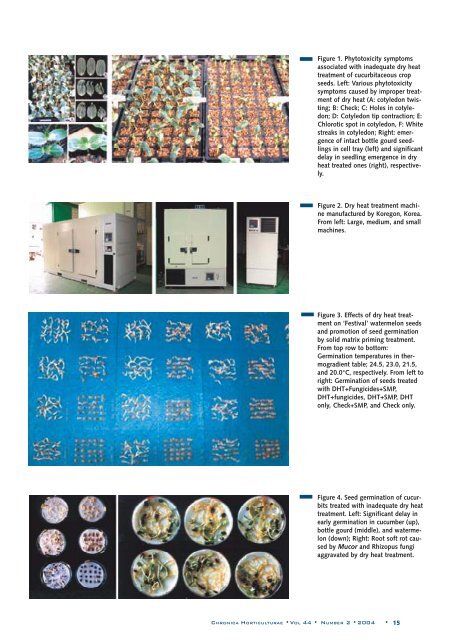Number 2 - 2004 - Acta Horticulturae
Number 2 - 2004 - Acta Horticulturae
Number 2 - 2004 - Acta Horticulturae
You also want an ePaper? Increase the reach of your titles
YUMPU automatically turns print PDFs into web optimized ePapers that Google loves.
Figure 1. Phytotoxicity symptoms<br />
associated with inadequate dry heat<br />
treatment of cucurbitaceous crop<br />
seeds. Left: Various phytotoxicity<br />
symptoms caused by improper treatment<br />
of dry heat (A: cotyledon twisting;<br />
B: Check; C: Holes in cotyledon;<br />
D: Cotyledon tip contraction; E:<br />
Chlorotic spot in cotyledon, F: White<br />
streaks in cotyledon; Right: emergence<br />
of intact bottle gourd seedlings<br />
in cell tray (left) and significant<br />
delay in seedling emergence in dry<br />
heat treated ones (right), respectively.<br />
Figure 2. Dry heat treatment machine<br />
manufactured by Koregon, Korea.<br />
From left: Large, medium, and small<br />
machines.<br />
Figure 3. Effects of dry heat treatment<br />
on ‘Festival’ watermelon seeds<br />
and promotion of seed germination<br />
by solid matrix priming treatment.<br />
From top row to bottom:<br />
Germination temperatures in thermogradient<br />
table; 24.5, 23.0, 21.5,<br />
and 20.0°C, respectively. From left to<br />
right: Germination of seeds treated<br />
with DHT+Fungicides+SMP,<br />
DHT+fungicides, DHT+SMP, DHT<br />
only, Check+SMP, and Check only.<br />
Figure 4. Seed germination of cucurbits<br />
treated with inadequate dry heat<br />
treatment. Left: Significant delay in<br />
early germination in cucumber (up),<br />
bottle gourd (middle), and watermelon<br />
(down); Right: Root soft rot caused<br />
by Mucor and Rhizopus fungi<br />
aggravated by dry heat treatment.<br />
CHRONICA HORTICULTURAE •VOL 44 • NUMBER 2 • <strong>2004</strong> • 15
















